Australian Skinks
|
|
FAMILY : Skinks
|
Eastern Three-lined Skink
(Bassiana duperreyi) |

|
The eastern three-lined skink (Acritoscincus duperreyi ), also known as the bold-striped cool-skink, is a species of skink, a lizard in the family Scincidae. The species is endemic to Australia. It has three bold lines running along the length of... Click to continue> |
|
Red-Throated Rainbow-Skink
(Carlia rubrigularis) |
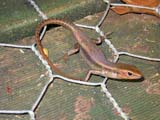
|
The Red-Throated Rainbow-Skink body is dark brown with flecks of darker and lighter colours. The head is copper-coloured and males often have bright copper coloured throat. The belly is whitish. Click to continue> |
|
Wall Skink
(Cryptoblepharus virgatus) |
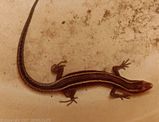
|
The Wall Skink has distinct white stripes along its body from the eye area to the base of its tail. Click to continue> |
|
Eastern Striped Skink
(Ctenotus robustus) |
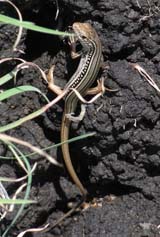
|
This Eastern Striped Skink is brown or olive-brown with stripes running along the length of the head and body. The underside is pale. The snout to vent length is about 11 cm, with total length about 23 cm. Click to continue> |
|
Leopard Ctenotus
(Ctenotus pantherinus) |
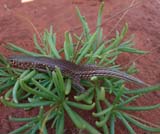
|
The Leopard Ctenotus is a grey to olive brown skink with white or yellow spots along the body. The snout to vent length is up to about 9 cm, with total length up to 22 cm. Click to continue> |
|
Striped Skink
(Ctenotus taeniolatus) |
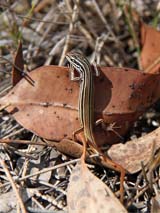
|
The Striped Skink is a medium sized skink. Striped Skinks are olive brown on top with stripes of dark brown and white running from head to tail. They have a black, white edged band along the centre of the back, and on either is a white band edged in... Click to continue> |
|
Cunningham's Skink
(Egernia cunninghami) |
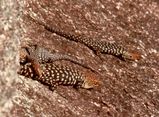
|
Cunningham's Skink colour varies from almost totally black with a few white spots, to grey with black bands, to rusty red colour. Click to continue> |
|
Hosmer's Skink
(Egernia hosmeri) |
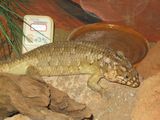
|
Hosmer's Skink is a spiny lizard with 3 or 4 sharp keels on each dorsal scale. It was one long spine on each tail scale. The body is pale yellow-brown or reddish brown. It has dark spots and pale blotches on the body - these are more prominent at... Click to continue> |
|
King's Skink
(Egernia kingii) |
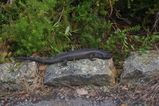
|
King's Skink is a sturdy dark grey, black or dark brown skink from coastal Western Australia. The under side is pale. Juveniles are marked with cream to yellow dots and streaks. Click to continue> |
|
Land Mullet
(Egernia major) |
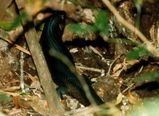
|
The Land Mullet is a large skink. Adults are glossy black or dark brown with a pale rim around the eye. Underside is white, yellow to orange-brown. Juveniles have white or cream spots on their side. Click to continue> |
|
Stoke's Skink
(Egernia stokesii) |

|
Stoke's Skink is a stocky skink with short legs. It varies in colour from reddish brown to greyish green, with scattering of pale spots. The tail is spiny and flattish. They are usually found in family groups of adults and juveniles living together. Click to continue> |
|
White's Skink
(Egernia whitii) |
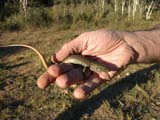
|
White's Skink is a stocky brownish coloured skink from south eastern Australia. The back often has dark brown and paler brown stripes along the length, but colour and pattern is variable. The sides are patterned with black and white speckles or... Click to continue> |
|
Broad-Banded Sand Swimmer
(Eremiascincus richardsonii) |
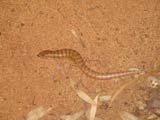
|
The Broad-Banded Sand Swimmer is pale brown or reddish brown with darker broad bands around its neck, body and tail. It has stout body and skinny legs moves across the sand with a "swimming" motion hence its common name. It is similar to the... Click to continue> |
|
Blue Mountain Water Skink
(Eulamprus leuraensis) |
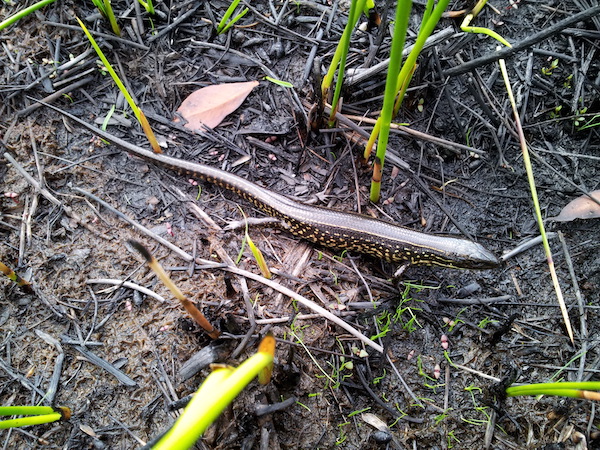
|
The Blue Mountain Water Skink is an endangered skink from the Blue Mountains region of New South Wales. It is dark brown with rows of pale spots on either side of the spine. The head is brown with black markings. The underside is cream or yellow... Click to continue> |
|
Eastern Water Skink
(Eulamprus quoyii) |
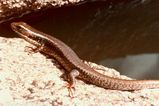
|
The Eastern Water Skink is a medium sized stocky long-tailed skink. It is dark brown to olive above and cream to white underneath. The tail is usually olive green. It has obvious external ear hole. It has sleek body and short legs. Click to continue> |
|
Yellow-bellied Water Skink
(Eulamprus heatwolei) |
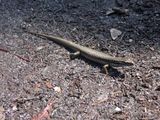
|
Light to dark golden brown above with numerous black flecks, sometimes with a pale dorsolateral line from eye to forelimb. Upper lateral area black with white flecks, lower lateral area greyish with black flecks. Anterior margin of the ear black.... Click to continue> |
|
Two-toed Earless Skink
(Hemiergis quadrilineata) |

|
Click to continue> |
|
Garden Skink
(Lampropholis delicata) |
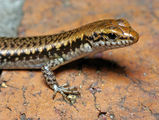
|
The Garden Skink is a small dark brown lizard, with bronze coloured stripe, from the shoulder and to the base of the tail. Click to continue> |
|
Pale-flecked Garden Sunskink
(Lampropholis guichenoti) |
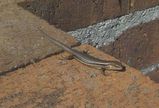
|
Small. Speckled grey to brown above with a bronzy head, dark sides and a ragged blackish stripe down the back. A well-defined white stripe may be present on the lower flanks.
Communal nesting is well known in this genus and the eggs of many... Click to continue> |
|
Boulenger's Skink
(Morethia boulengeri) |
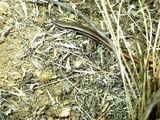
|
Click to continue> |
|
Metallic Skink
(Niveoscincus metallicus) |
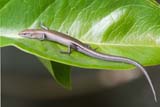
|
Click to continue> |
|
Tasmanian Tree Skink
(Niveoscincus pretiosus) |
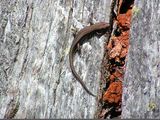
|
Click to continue> |
|
Weasel Skink
(Saproscincus mustelinus) |

|
Light brown to golden above, with scattered paler flecks. Lateral surface (sides) similar, but with a distinctive cream-white spot at the corner of the eye and an orange-red dorsolateral hip-stripe that runs above the hind limbs to the base of tail... Click to continue> |
|
Blotched Blue-tongue Lizard
(Tiliqua nigrolutea) |
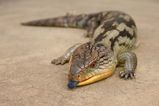
|
Body very dark on the back with light patches. Blue tongue. Up to 25 cm long (snout-vent).
Blotched Blue-tongues are slow-moving with the impressive defense display of hissing, sticking out their tongue and lunging at threats. They are... Click to continue> |
|
Centralian Blue-tongue Lizard
(Tiliqua multifasciata) |

|
A large skink. It is pale grey, bluish-grey or grey-brown, with numerous broad orange bands and a blackish stripe on the temple behind the eye.
Active by day, it searches for smaller animals and soft vegetation to eat. Shelters in holes,... Click to continue> |
|

